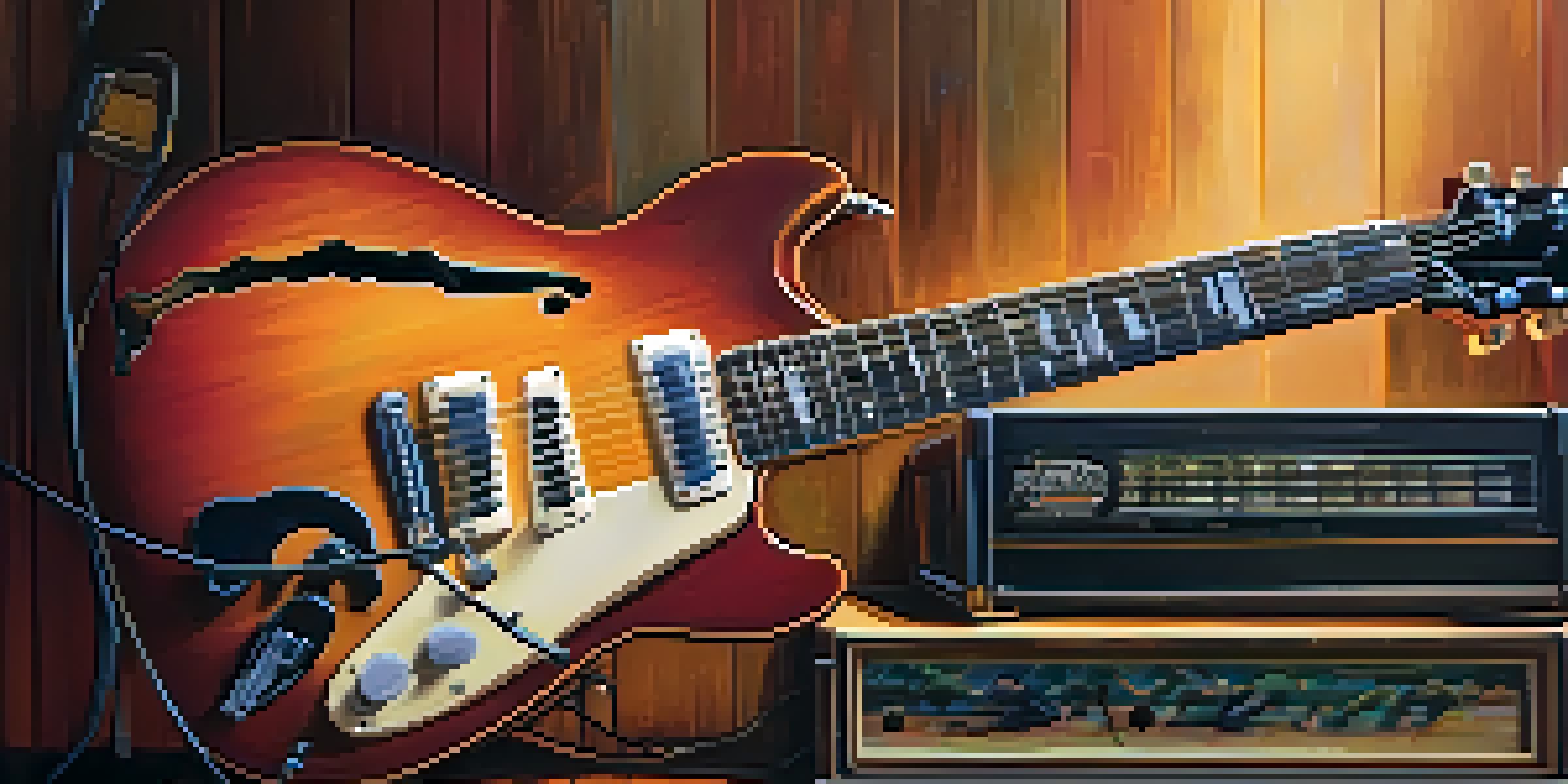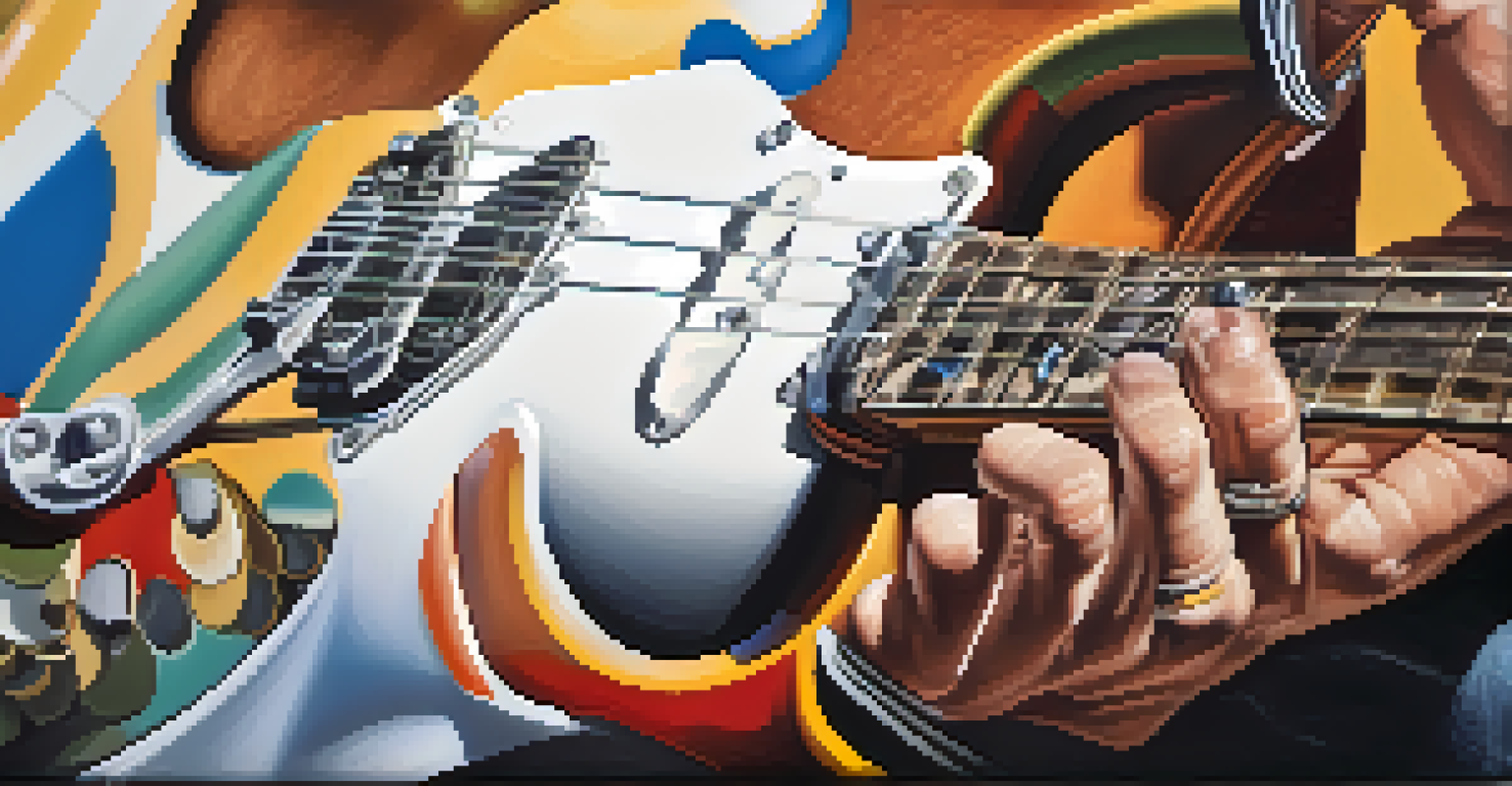The Electric Guitar's Evolution: Key Models and Milestones

The Birth of the Electric Guitar: A Game Changer
The electric guitar made its debut in the early 1930s, changing the music landscape forever. Before this invention, guitars were mostly acoustic, relying on their hollow bodies to project sound. The introduction of electromagnetic pickups allowed for greater volume and sustain, making it possible for guitarists to perform in larger venues.
The electric guitar is a wonderful instrument. It’s a beautiful piece of art, and it can take you anywhere you want to go musically.
One of the first commercially successful electric guitars was the Rickenbacker
which became iconic for its distinct sound and design. This innovation not only paved the way for future electric guitars but also inspired countless musicians to explore new sounds. With the electric guitar, artists could now express themselves in ways that were previously unimaginable.
The 1940s to 1950s: Solid Body Designs Take Center Stage
The solid body electric guitar began to gain popularity in the 1940s, with models like the Fender Telecaster leading the charge. Unlike hollow-bodied guitars, solid bodies reduce feedback and enhance sustain, making them ideal for rock and roll and jazz music. This era saw an explosion of creativity as musicians experimented with different sounds and styles.
Electric Guitar Revolutionizes Music
The introduction of the electric guitar in the 1930s transformed musical expression and performance capabilities for artists.

Gibson also entered the scene with the Les Paul model, which became a staple in rock music. The combination of its rich tone and sustain made it a favorite among guitar legends like Eric Clapton and Jimmy Page. This period was pivotal, as it laid the foundation for the sound of modern rock music that we know today.
The 1960s: Innovation and Cultural Revolution
The 1960s were a time of cultural upheaval, and the electric guitar played a central role in this revolution. Artists like Jimi Hendrix and The Beatles pushed the boundaries of what was possible with guitar sound and technique. They used feedback, distortion, and various effects to create new musical landscapes that resonated deeply with the youth of the time.
The guitar is the easiest instrument to play and the hardest to play well.
New models emerged, including the Fender Stratocaster, which became synonymous with rock music. Its contoured body and versatility made it a go-to choice for countless musicians. This era not only marked the electric guitar's rise to fame but also solidified its place as a symbol of rebellion and creativity.
The 1970s: Diversity in Style and Sound
As music genres diversified in the 1970s, so did the electric guitar. From the intricate solos of progressive rock to the raw energy of punk, guitarists experimented with different styles and techniques. This decade saw the emergence of influential models like the Gibson SG and the Fender Jazzmaster, each catering to unique musical needs.
Diverse Styles Emerge in the 1970s
The 1970s saw the electric guitar adapt to various genres, showcasing its versatility through innovative playing styles and new models.
Artists such as Eddie Van Halen redefined the instrument with innovative playing styles, including tapping and harmonics. The electric guitar became a canvas for personal expression, and musicians began to explore its full potential. This era was a testament to the guitar's ability to adapt and evolve with the changing musical landscape.
The 1980s: Technological Advancements and New Sounds
The 1980s ushered in an era of technological advancements that transformed the electric guitar landscape. The introduction of MIDI technology and digital effects enabled guitarists to explore new sonic territories. This decade saw the rise of iconic models like the Ibanez RG and the Jackson Soloist, which catered to the burgeoning heavy metal scene.
Guitar heroes like Joe Satriani and Steve Vai showcased their prowess, inspiring a new generation of musicians. The electric guitar became a symbol of technical skill and innovation, pushing the boundaries of what could be achieved. As guitarists embraced these new technologies, they expanded their creative horizons and redefined the instrument's role in modern music.
The 1990s: Grunge and Alternative Rock Influence
The 1990s saw a shift in musical tastes as grunge and alternative rock took center stage. Bands like Nirvana and Pearl Jam brought a raw, unpolished sound that resonated with audiences. The electric guitar, particularly models like the Fender Mustang, became emblematic of this movement, emphasizing simplicity over technicality.
21st Century: Tradition Meets Tech
Modern guitarists blend traditional techniques with advanced technology, ensuring the electric guitar remains a vital instrument in contemporary music.
This decade also saw the resurgence of vintage models, as musicians sought authenticity in their sound. The electric guitar was no longer just a tool for virtuosos; it became accessible to all musicians. This democratization of the instrument allowed for a diverse range of voices to emerge, enriching the musical landscape.
The 21st Century: A Blend of Tradition and Innovation
As we moved into the 21st century, the electric guitar continued to evolve while staying rooted in its rich history. Modern guitarists blend traditional techniques with cutting-edge technology, creating a unique fusion of sounds. The resurgence of boutique guitar builders has led to a renewed interest in craftsmanship and quality.
Digital effects and software have also transformed how musicians create and record music. Guitarists can now manipulate their sound in ways previously unimaginable, opening new doors for creativity. This blend of tradition and innovation ensures that the electric guitar remains relevant and continues to inspire future generations.